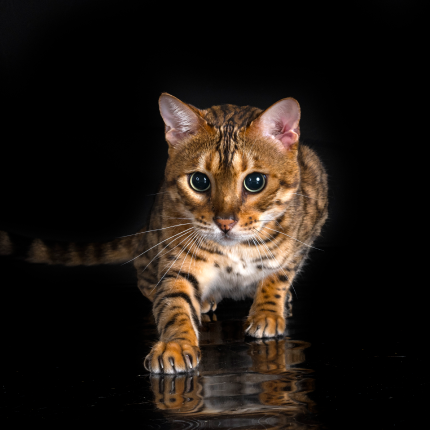Cats Aren’t Predators, They’re Mesopredators

Ever wonder why your cat seems to be both a skilled hunter and a silly little guy that can be easily scared? Like when the’yre surprised by a cucumber? Well despite the fact that not only do cats hunt and kill prey (sometimes too well) they aren’t classified as predators, they are what’s called a mesopredator.
What is a Mesopredator?
Mesopredators are medium-sized carnivores that occupy a middle position in the food chain. They are not apex predators like large carnivores such as wolves or big cats, nor are they prey species. Instead, mesopredators like cats often prey on smaller animals while themselves being hunted by larger predators.
The Evolution of Cats as Mesopredators
Cats, both domestic and wild species like the common house cat (Felis catus) and feral cats, have evolved over millennia to become efficient hunters. Their agility, stealth, and sharp senses make them formidable predators capable of hunting a wide range of prey, from rodents and birds to insects and small mammals.
However, despite their prowess as hunters, cats’ position as mesopredators means they often live with a sense of vulnerability. Unlike apex predators, they are not at the top of the food chain and must constantly be aware of potential threats from larger predators. This inherent fear drives their instinctual behaviors, including vigilance, cautiousness, and territoriality.
Historically, cats played a vital role in controlling pest populations, particularly in agricultural settings where rodents posed a threat to crops and stored food supplies. However, as human populations have grown and urbanized, cats have adapted to new environments, including cities and suburbs, where they continue to thrive as mesopredators.
Impact on Wildlife
While cats are skilled hunters, their predatory behavior can have significant consequences for native wildlife populations, particularly in ecosystems where they are introduced species or invasive predators. Feral cats, in particular, can have devastating effects on vulnerable bird species, small mammals, and reptiles.
Studies have shown that free-roaming cats, including feral and outdoor domestic cats, kill billions of birds and small mammals each year in the United States alone. These predation rates can have cascading effects on local ecosystems, disrupting food chains and contributing to declines in native species populations.
Managing Cat Populations
Given the ecological impact of cats as mesopredators, managing their populations has become a topic of increasing concern among conservationists, wildlife biologists, and policymakers. Various strategies have been proposed to address the issue, including:
- Trap-Neuter-Return (TNR) Programs: TNR programs aim to humanely trap feral cats, sterilize them to prevent breeding, and return them to their original habitat. While TNR programs can help control cat populations, they may not be sufficient to address the ecological impact of feral cat predation on wildlife.
- Indoor Cat Policies: Encouraging pet owners to keep their cats indoors can help reduce their hunting impact on native wildlife. Providing environmental enrichment and mental stimulation for indoor cats can help mitigate the risks of boredom and behavioral problems associated with confinement.
- Community Education and Outreach: Educating the public about the importance of responsible pet ownership, including spaying and neutering cats, keeping them indoors or in enclosed outdoor spaces, and supporting wildlife conservation efforts, can help raise awareness and foster positive behavior change.
Balancing Conservation and Companion Animal Welfare
Finding a balance between conservation efforts and the welfare of companion animals like cats is essential for addressing the complex issues surrounding their role as mesopredators. By implementing evidence-based management strategies, promoting responsible pet ownership, and supporting habitat conservation efforts, we can work towards creating healthier ecosystems where both wildlife and pets can thrive.
Cats occupy a unique niche as mesopredators in ecosystems worldwide. While they are cherished companions to millions of people, their predatory behavior can have significant implications for native wildlife populations. By understanding and addressing the ecological impact of cats, we can take meaningful steps towards preserving biodiversity and creating harmonious relationships between humans, pets, and the natural world.

Featured Articles

Why Do Cats Roll Over Into Their Backs But Not Let You Touch Their Bellies?
It’s common knowledge dogs love to have their tummies rubbed when they freely lay down before you and roll onto their backs. But, if you’re also familiar with cats, you know that when they roll onto their backs with their bellies exposed, rubbing the belly will most likely result in…

Greebles and Cats: The Origin and the Meaning
You may have seen an internet sensation concerning cats labeled “greebles.” Feel out of the loop? We’re here to help you. In 2019, Reddit user /user/literallyatree commented on a Reddit post about a cat that looks like it’s trying to slap a ghost. This user commented: “My family calls things…

Polydactyl Cats: Just More Beans to Love
Polydactyl cats have become extremely popular in recent times. As a result, more and more people are interested in learning more about this six-toed cat and want to get one of their own. If you are a cat lover intrigued by polydactyl cats, you have come to the right place….